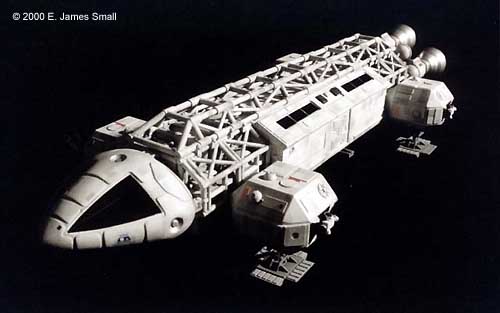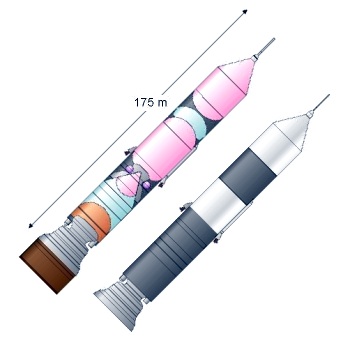
Posted on 01/18/2005 5:35:31 PM PST by KevinDavis
EDWARDS AIR FORCE BASE -- NASA will select two teams of aerospace companies to compete for a contract to build a new manned spaceship that will anchor President George W. Bush's plan to send astronauts back to the moon.
A year after Bush announced his initiative to return man to the moon, NASA's top official says the agency will seek proposals this spring from the aerospace industry for the new spacecraft, called the crew exploration vehicle.
(Excerpt) Read more at dailynews.com ...

We should have seen a lot more of this by now. Instead we get invitations to bid on janitorial services and road maintenance.

If they took all of the money they are going to spend on this (and I'm sure the big aerospace companies and various Senators and Representatives are going to lobby hard for a lot of money) and split it among any company that can meet the X-Prize criteria one year from now (including Rutan's group that won it last year). It'd probably go a lot further, have less chance of being wasted (large companies plus the government plus large projects have way too much mission and budget creep), and it could even give us multiple spacecraft to get to the Moon - even better.
Send all the RATs tolonize the Moon - Moonskie Socialist Sky Union and have only gay marriages allowed.
tolonize = to colonize (or not)
Cool stuff. Git-r-done.

Pres Bush will talk about his Ownership Society in his Inauguration speech. He should announce also besides Social Security that he will create private property rights in space. Anything short of that and he is a lame duck.
The only valid reason to send humans into space is to claim ore bodies for the country and then allow for private rights to be established.
WHY aren't we ALREADY Building the new "Spaceships to the Moon??"
WHAT's the "Hold-up??"
We should be LONG SINCE, "On the Way to the Moon!!"
WHO "Screwed the Pooch;" & DELAYED our Return to the Moon??
"W" Said we are "Going Out!!--" "WHAT's the "Hold-up??"
There is NO Possibility that "America" will "Shirk our STATED Goals;"-- The American People will Adhere to the "Standards" we have accepted; Americans ADHERE to our "Agreements!"
& So we accept our Current Status, BUT we Expect More; we accept, "W", & we EXPECT to "Go ON!!--"
Americans DO NOT "Live For" the "Status Quo;" WE LIVE FOR our FUTURE!!
We Don't "Live For" our current "Status Quo;" we expect our Future Lives will be ongoing examples of Examples of Future Behavior.
Doc
I made a few good paper planes at school that I used to throw off the top floor of the science building. Where do I apply ?
I know there are arguements to be made for that premise. I would however point out that space is the high ground, and it is strategicly important that we are the ones who control that high ground. Our government is compelled to see this happen, one way or another.
One of the serious ramifications of lighting China's economic fire, was that we were setting in place a nation five times our size as a competitor. That competitior will be entering space. It will wind up with a tax base two to five times our size.
What that takes place, we're going to be in a world of hurt trying to keep them from turning into a near-space nightmare.
There is NO "Legacy" that "W" could have, MORE HISTORICALLY IMPORTANT than his effort to Re-Establish the Space Program.
The effect of a "Re-Invigorated Space Program" on our Culture is Incalculably Positive; America NEEDS a "Positive Impetus!!"
If "America" lacks a "Will to Succeed,;" then ALL of "Modern Society" will COLLAPSE--& We'll HAVE TO "GO BACK TO" "BARBARISM," & we'll LOSE 30 Generations of Civilization!!
Doc

FUTURE LAUNCH VEHICLE PLANS [1963-2001]
DETAILS ON SEA DRAGON
Sea Dragon was a two-stage design of 1962 capable of putting 1.2 million pounds (550 tonnes) into low Earth orbit. The concept was to achieve minimum launch costs through lower development and production costs. This meant accepting a larger booster with a lower performance propulsion system and higher stage dead weight then traditional NASA and USAF designs. The first stage had a single pressure fed, thrust chamber of 36 million kgf thrust, burning LOX/Kerosene. The second stage was ‘considerably smaller’ (thrust only 6.35 million kgf!) and burned LOX/LH2. The complete vehicle was 23 m in diameter and 150 m long. The all-up weight was 18,000 tonnes. The launch vehicle would be fuelled with RP-1 kerosene in port, then towed horizontally to a launch point in the open ocean. It would then be filled with cryogenic liquid oxygen and hydrogen from tankers or produced by electrolysis of sea water by a nuclear aircraft carrier (such as the CVN Enterprise in the painting). After fuelling, the tanks at the launcher base would be flooded, and the vehicle would reach a vertical position in the open ocean. Launch would follow. The concept was proven with tests of the earlier Sea Bee and Sea Horse vehicles. Aside from the baseline two stage expendable version, a single-stage-to-orbit reusable vehicle with a plug nozzle was designed. Costs to low earth orbit were estimated to be between $60/kg and $600/kg - eg one fourth that of the Saturn V or less.
Stage one used liquid nitrogen to force the propellants into the engine. At ignition, combustion chamber pressure was 20 atmospheres, and kerosene was forced into the chamber at a pressure of 32 atmospheres and liquid oxygen at 17 atmospheres. By burnout 81 seconds later combustion chamber pressure had declined to 14 atmospheres, kerosene feed pressure to 20 atmospheres, and liquid oxygen pressure to 8.5 atmospheres. At burnout the stage had reached a velocity of 1.8 km/second at an altitude of 40 km and a range of 33 km. After separation the stage would impact the ocean 290 km downrange (one alternate was recovery and reuse of the stage). Losses due to gravity and drag were minimised by the high 2:1 thrust-to-weight ratio and low drag losses (deceleration at max q was about 0.2 G’s ) resulting from the large size of the booster.
Stage two had a burn time of 260 seconds and a low constant combustion chamber pressure of 7 atmospheres. The stage achieved a total delta V of 5.8 km/second, shutting down at orbital velocity at an altitude of 230 km and 940 km downrange from the launch point. A significant feature of the concept was the use of an expandable nozzle exit cone. This increased the area ratio of the nozzle from 7:1 to 27:1 when deployed. Initial tests showed considerable promise, but development ceased because of lack of in-house funding. This concept was later fully developed under the solid rocket Peacekeeper program.
The design was reviewed with Todd Shipyards, who concluded that it was well within their capabilities, and not too unlike making a submarine hull. 8 mm thick maraging steel was used, similar to the Aerojet 260 inch solid motor of the time. NASA Marshall gave the Aerojet designs to TRW for evaluation. TRW fully confirmed Aerojet's costs and engineering, a great surprise to both TRW and NASA. Aerojet was considering purchasing Sudden Ranch as a launch site for Sea Dragon. This property included several kilometres of coastline between Santa Barbara and Vandenberg AFB. This was the only site on the continental United States that could launch directly into a polar orbit without overflying populated areas (and was later incorporated into Vandenberg).
But this came just as Apollo was being cut back and the Viet Nam war was eating an ever greater amount of the US budget. NASA dissolved their Future Projects Branch (dropping almost all the manned Mars landing work). Prospects for Sea Dragon essentially disappeared, and Aerojet could no longer fund it on IR&D.
Disclaimer: Opinions posted on Free Republic are those of the individual posters and do not necessarily represent the opinion of Free Republic or its management. All materials posted herein are protected by copyright law and the exemption for fair use of copyrighted works.